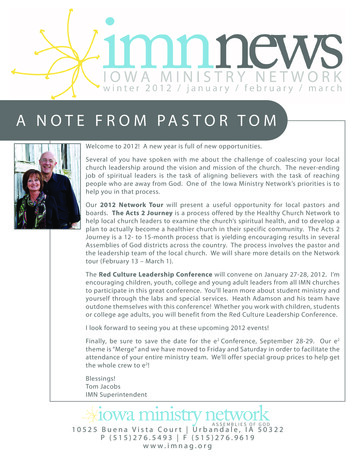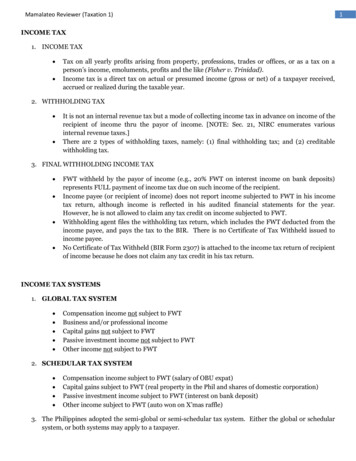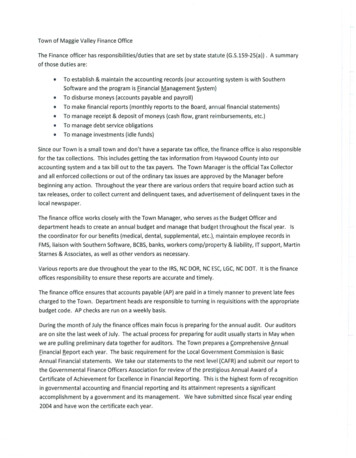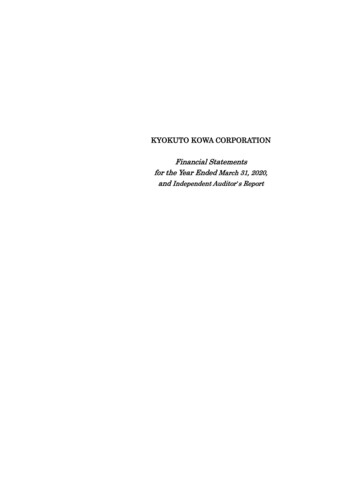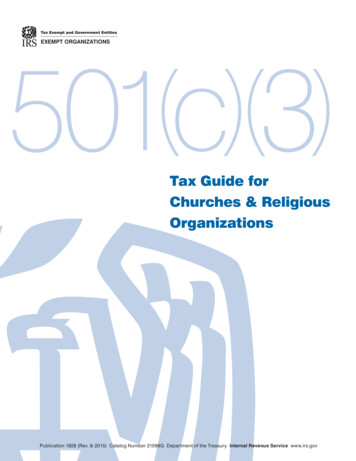
Transcription
Tax Exempt and Government Entities()()501c 3EXEMPT ORGANIZATIONSTax Guide forChurches & ReligiousOrganizationsPublication 1828 (Rev. 8-2015) Catalog Number 21096G Department of the Treasury Internal Revenue Service www.irs.gov
Congress has enacted special tax laws that apply to churches, religious organizations andministers in recognition of their unique status in American society and of their rights guaranteed by the First Amendment of the Constitution of the United States. Churches and religiousorganizations are generally exempt from income tax and receive other favorable treatmentunder the tax law; however, certain income of a church or religious organization may besubject to tax, such as income from an unrelated business.The Internal Revenue Service offers this quick reference guide of federal tax law and procedures for churches and religious organizations to help them voluntarily comply with tax rules.The contents of this publication reflect the IRS interpretation of tax laws enacted by Congress,Treasury regulations and court decisions. The information given is not comprehensive,however, and doesn’t cover every situation. Thus, it isn’t intended to replace the law or be thesole source of information. The resolution of any particular issue may depend on the specificfacts and circumstances of a given taxpayer. In addition, this publication covers subjects onwhich a court may have made a decision more favorable to taxpayers than the interpretationby the IRS. Until these differing interpretations are resolved by higher court decisions, or insome other way, this publication will present the interpretation of the IRS.For more detailed tax information, the IRS has assistance programs and tax informationproducts for churches and religious organizations, as noted at the end of this publication.Most IRS publications and forms can be downloaded from the IRS website at www.irs.gov.Specialized information can be accessed through the Exempt Organizations (EO) websiteunder the IRS Tax Exempt and Government Entities division at www.irs.gov/eo or by callingEO Customer Account Services toll free at 877-829-5500.The IRS considers this publication a living document, one that will be revised to take intoaccount future developments and feedback. Comments on the publication may be submittedto the IRS at:Internal Revenue Service1111 Constitution Avenue, NWWashington, DC 20224 Attn: SE:T:C&L
ContentsIntroduction . . . . . . . . . . . . . . . . . . . . . . . . . . . . . . . . . . . . . . . . . . . . . . . . . . . . . . . . . . . . . 1Tax-Exempt Status . . . . . . . . . . . . . . . . . . . . . . . . . . . . . . . . . . . . . . . . . . . . . . . . . . . . . . . . . . . 2Recognition of Tax-Exempt Status . . . . . . . . . . . . . . . . . . . . . . . . . . . . . . . . . . . . . . . . . . . . . . 2Applying for Tax-Exempt Status . . . . . . . . . . . . . . . . . . . . . . . . . . . . . . . . . . . . . . . . . . . . . . . . 3Public Listing of Tax-Exempt Organizations . . . . . . . . . . . . . . . . . . . . . . . . . . . . . . . . . . . . . . . 4Jeopardizing Tax-Exempt Status . . . . . . . . . . . . . . . . . . . . . . . . . . . . . . . . . . . . . . . . . . . . . 4Inurement and Private Benefit . . . . . . . . . . . . . . . . . . . . . . . . . . . . . . . . . . . . . . . . . . . . . . . . . . 5Substantial Lobbying Activity . . . . . . . . . . . . . . . . . . . . . . . . . . . . . . . . . . . . . . . . . . . . . . . . . . 6Measuring Lobbying Activity . . . . . . . . . . . . . . . . . . . . . . . . . . . . . . . . . . . . . . . . . . . . . . . . . . . 6Political Campaign Activity . . . . . . . . . . . . . . . . . . . . . . . . . . . . . . . . . . . . . . . . . . . . . . . . . . . . . 7Unrelated Business Income Tax (UBIT) . . . . . . . . . . . . . . . . . . . . . . . . . . . . . . . . . . . . . . 19Net Income Subject to the UBIT . . . . . . . . . . . . . . . . . . . . . . . . . . . . . . . . . . . . . . . . . . . . . . . 19Examples of Unrelated Trade or Business Activities . . . . . . . . . . . . . . . . . . . . . . . . . . . . . . . . 19Tax on Income-Producing Activities . . . . . . . . . . . . . . . . . . . . . . . . . . . . . . . . . . . . . . . . . . . . 20Employment Tax . . . . . . . . . . . . . . . . . . . . . . . . . . . . . . . . . . . . . . . . . . . . . . . . . . . . . . . . . 21Social Security and Medicare Taxes — Federal Insurance Contributions Act (FICA) . . . . . . 21Federal Unemployment Tax Act (FUTA) . . . . . . . . . . . . . . . . . . . . . . . . . . . . . . . . . . . . . . . . . . 22Special Rules for Compensation of Ministers . . . . . . . . . . . . . . . . . . . . . . . . . . . . . . . . . 22Withholding Income Tax for Ministers . . . . . . . . . . . . . . . . . . . . . . . . . . . . . . . . . . . . . . . . . . . 22Parsonage or Housing Allowances . . . . . . . . . . . . . . . . . . . . . . . . . . . . . . . . . . . . . . . . . . . . . 22Social Security and Medicare Taxes — Federal Insurance Contributions Act (FICA)vs. Self-Employment Contributions Act (SECA) . . . . . . . . . . . . . . . . . . . . . . . . . . . . . . . . . . . . 23Payment of Employee Business Expenses . . . . . . . . . . . . . . . . . . . . . . . . . . . . . . . . . . . 24Accountable Reimbursement Plan . . . . . . . . . . . . . . . . . . . . . . . . . . . . . . . . . . . . . . . . . . . . . . 24Non-accountable Reimbursement Plan . . . . . . . . . . . . . . . . . . . . . . . . . . . . . . . . . . . . . . . . . . 24iii
Recordkeeping Requirements . . . . . . . . . . . . . . . . . . . . . . . . . . . . . . . . . . . . . . . . . . . . . . 25Books of Accounting and Other Types of Records . . . . . . . . . . . . . . . . . . . . . . . . . . . . . . . . . 25Length of Time to Retain Records . . . . . . . . . . . . . . . . . . . . . . . . . . . . . . . . . . . . . . . . . . . . . . 26Filing Requirements . . . . . . . . . . . . . . . . . . . . . . . . . . . . . . . . . . . . . . . . . . . . . . . . . . . . . 27Information and Tax Returns — Forms to File and Due Dates . . . . . . . . . . . . . . . . . . . . . . . . 27Charitable Contributions— Substantiation and Disclosure Rules . . . . . . . . . . . . . . . . . 29Recordkeeping . . . . . . . . . . . . . . . . . . . . . . . . . . . . . . . . . . . . . . . . . . . . . . . . . . . . . . . . . . . . . 29Recordkeeping Rules . . . . . . . . . . . . . . . . . . . . . . . . . . . . . . . . . . . . . . . . . . . . . . . . . . . . . . . . 29Substantiation Rules . . . . . . . . . . . . . . . . . . . . . . . . . . . . . . . . . . . . . . . . . . . . . . . . . . . . . . . . . 29Disclosure Rules that Apply to Quid Pro Quo Contributions . . . . . . . . . . . . . . . . . . . . . . . . . . 30Exceptions to Disclosure Statement . . . . . . . . . . . . . . . . . . . . . . . . . . . . . . . . . . . . . . . . . . . . 30Special Rules Limiting IRS Authority to Audit a Church . . . . . . . . . . . . . . . . . . . . . . . . . 31Tax Inquiries and Examinations of Churches . . . . . . . . . . . . . . . . . . . . . . . . . . . . . . . . . . . . . . 31Audit Process . . . . . . . . . . . . . . . . . . . . . . . . . . . . . . . . . . . . . . . . . . . . . . . . . . . . . . . . . . . . . . 32Glossary . . . . . . . . . . . . . . . . . . . . . . . . . . . . . . . . . . . . . . . . . . . . . . . . . . . . . . . . . . . . . . . 33Help From The IRS . . . . . . . . . . . . . . . . . . . . . . . . . . . . . . . . . . . . . . . . . . . . . . . . . . . . . . . 35IRS Tax Publications . . . . . . . . . . . . . . . . . . . . . . . . . . . . . . . . . . . . . . . . . . . . . . . . . . . . . . . . 35IRS Customer Service . . . . . . . . . . . . . . . . . . . . . . . . . . . . . . . . . . . . . . . . . . . . . . . . . . . . . . . 36EO Customer Service . . . . . . . . . . . . . . . . . . . . . . . . . . . . . . . . . . . . . . . . . . . . . . . . . . . . . . . . 36EO Website . . . . . . . . . . . . . . . . . . . . . . . . . . . . . . . . . . . . . . . . . . . . . . . . . . . . . . . . . . . . . . . . 36EO Update . . . . . . . . . . . . . . . . . . . . . . . . . . . . . . . . . . . . . . . . . . . . . . . . . . . . . . . . . . . . . . . . . 36iv
IntroductionThis publication explains the benefits and the responsibilities under the federal tax system forchurches and religious organizations. The term church is found, but not specifically defined, inthe Internal Revenue Code (IRC). The term is not used by all faiths; however, in an attempt tomake this publication easy to read, we use it in its generic sense as a place of worship including, for example, mosques and synagogues. With the exception of the special rules for churchaudits, the use of the term church throughout this publication also includes conventions andassociations of churches as well as integrated auxiliaries of a church.Because special tax rules apply to churches, it’s important to distinguish churches from otherreligious organizations. Therefore, when this publication uses the term “religious organizations,” it isn’t referring to churches or integrated auxiliaries. Religious organizations that are notchurches typically include nondenominational ministries, interdenominational and ecumenicalorganizations, and other entities whose principal purpose is the study or advancement of religion.Churches and religious organizations may be legally organized in a variety of ways under statelaw, such as unincorporated associations, nonprofit corporations, corporations sole and charitable trusts.Certain terms used throughout this publication—church, integrated auxiliary of a church, minister and IRC Section 501(c)(3) — are defined in the Glossary.1
Tax-Exempt StatusChurches and religious organizations, like many other charitable organizations,qualify for exemption from federal income tax under IRC Section 501(c)(3) and aregenerally eligible to receive tax-deductible contributions. To qualify for tax-exemptstatus, the organization must meet the following requirements (covered in greaterdetail throughout this publication):the organization must be organized and operated exclusively for religious,educational, scientific or other charitable purposes;nnnet earnings may not inure to the benefit of any private individual or shareholder;nno substantial part of its activity may be attempting to influence legislation;nthe organization may not intervene in political campaigns; andthe organization’s purposes and activities may not be illegal or violatefundamental public policy.nRecognition of Tax-Exempt StatusAutomatic Exemption for ChurchesChurches that meet the requirements of IRC Section 501(c)(3) are automaticallyconsidered tax exempt and are not required to apply for and obtain recognition oftax-exempt status from the IRS.Although there is no requirement to do so, many churches seek recognition oftax-exempt status from the IRS because this recognition assures church leaders,members and contributors that the church is recognized as exempt and qualifiesfor related tax benefits. For example, contributors to a church that has beenrecognized as tax exempt would know that their contributions generally aretax-deductible.Church Exemption Through a Central/Parent OrganizationA church with a parent organization may wish to contact the parent to see if ithas a group ruling. If the parent holds a group ruling, then the IRS may alreadyrecognize the church as tax exempt. Under the group exemption process, theparent organization becomes the holder of a group ruling that identifies otheraffiliated churches or other affiliated organizations. A church is recognized as taxexempt if it is included in a list provided by the parent organization. If the churchor other affiliated organization is included on the list, it doesn’t need to take furtheraction to obtain recognition of tax-exempt status.An organization that isn’t covered under a group ruling should contact its parentorganization to see if it’s eligible to be included in the parent’s application forthe group ruling. For general information on the group exemption process, seePublication 4573, Group Exemptions, and Revenue Procedure 80-27, 1980-1 C.B. 677.2
Religious OrganizationsUnlike churches, religious organizations that wish to be tax exempt generally mustapply to the IRS for tax-exempt status unless their gross receipts do not normallyexceed 5,000 annually.Applying for Tax-Exempt StatusEmployer Identification Number (EIN)Every tax-exempt organization, including a church, should have an employer identification number whether or not the organization has any employees. There aremany instances in which an EIN is necessary. For example, a church needs an EINwhen it opens a bank account, to be listed as a subordinate in a group ruling or ifit files returns with the IRS (for example, Forms W-2, 1099, 990-T).An organization may obtain an EIN by filing Form SS-4, Application for EmployerIdentification Number, according to its instructions. If the organization is submittingIRS Form 1023, Application for Recognition of Exemption Under Section 501(c)(3) ofthe Internal Revenue Code, Form SS-4 should be included with the application.Application FormWhen applying for recognition as tax exempt under IRC Section 501(c)(3),churches and some religious organizations must use Form 1023. Smaller religiousorganizations may be eligible to use Form 1023-EZ, Streamlined Application forRecognition of Exemption Under Section 501(c)(3) of the Internal Revenue CodeA religious organization generally must submit its application within 27 monthsfrom the end of the month in which the organization is formed to be considered taxexempt and qualified to receive deductible contributions as of the date the organization was formed. On the other hand, a church may obtain recognition of exemption from the date of its formation as a church, even though that date may be priorto 27 months from the end of the month in which its application is submitted.Cost of applying for exemption. The IRS is required to collect a non-refundablefee from any organization seeking a determination of tax-exempt status under IRCSection 501(c)(3). Although churches are not required by law to file an applicationfor exemption, if they choose to do so voluntarily, they’re required to pay the fee fordetermination.The fee must be submitted with Form 1023; otherwise, the application will bereturned to the submitter. Fees change periodically. The most recent user fee canbe found at the Exempt Organizations (EO) website under the IRS Tax Exempt andGovernment Entities Division via www.irs.gov/eo (key word “user fee”) or by callingEO Customer Account Services toll-free at 877-829-5500.3
IRS Approval of Exemption ApplicationIf the application for tax-exempt status is approved, the IRS will notify theorganization of its status, any requirement to file an annual information return andits eligibility to receive deductible contributions. The IRS does not assign a specialnumber or other identification as evidence of an organization’s tax-exempt status.Public Listing of Tax-Exempt OrganizationsExempt Organizations Select Check is an online search tool that allows users tosearch for organizations that are eligible to receive tax-deductible charitablecontributions. Note that not every organization that is eligible to receive tax-deductiblecontributions is listed on Select Check. For example, churches that have not appliedfor recognition of tax-exempt status are not included in the publication. Only the parentorganization in a group ruling is included by name on Select Check.Select Check also allows users to search for organizations whose tax-exemptstatus has been automatically revoked because they have not met their annualfiling requirement for three consecutive years. In addition, users may search SelectCheck for organizations that have filed a Form 990-N (e-Postcard) annual electronicnotice.If you have questions about listing an organization, correcting an erroneous entryor deleting a listing on Select Check, contact EO Customer Account Servicestoll-free at 877-829-5500.Jeopardizing Tax-Exempt StatusAll IRC Section 501(c)(3) organizations, including churches and religiousorganizations, must abide by certain rules:ntheir net earnings may not inure to any private shareholder or individual;nthey must not provide a substantial benefit to private interests;they must not devote a substantial part of their activities to attempting toinfluence legislation;nthey must not participate in, or intervene in, any political campaign on behalf of(or in opposition to) any candidate for public office; andnthe organization’s purposes and activities may not be illegal or violatefundamental public policy.n4
Inurement and Private BenefitInurement to InsidersChurches and religious organizations, like all exempt organizations under IRCSection 501(c)(3), are prohibited from engaging in activities that result in inurementof the church’s or organization’s income or assets to insiders (such as personshaving a personal and private interest in the activities of the organization). Insiderscould include the minister, church board members, officers, and in certain circumstances, employees. Examples of prohibited inurement include the payment ofdividends, the payment of unreasonable compensation to insiders and transferringproperty to insiders for less than fair market value. The prohibition againstinurement to insiders is absolute; therefore, any amount of inurement is, potentially, grounds for loss of tax-exempt status. In addition, the insider involved maybe subject to excise tax. See the following section on Excess benefit transactions.Note that prohibited inurement doesn’t include reasonable payments for servicesrendered, payments that further tax-exempt purposes or payments made for thefair market value of real or personal property.Excess benefit transactions. In cases where an IRC Section 501(c)(3) organization provides an excess economic benefit to an insider, both the organization andthe insider have engaged in an excess benefit transaction. The IRS may impose anexcise tax on any insider who improperly benefits from an excess benefit transaction, as well as on organization managers who participate in the transaction knowing that it’s improper. An insider who benefits from an excess benefit transactionmust return the excess benefits to the organization. Detailed rules on excessbenefit transactions are contained in the Code of Federal Regulations, Title 26,sections 53.4958-0 through 53.4958-8.Private BenefitAn IRC Section 501(c)(3) organization’s activities must be directed exclusivelytoward charitable, educational, religious or other exempt purposes. The organization’s activities may not serve the private interests of any individual or organization.Rather, beneficiaries of an organization’s activities must be recognized objects ofcharity (such as the poor or the distressed) or the community at large (for example, through the conduct of religious services or the promotion of religion). Privatebenefit is different from inurement to insiders. Private benefit may occur even ifthe persons benefited are not insiders. Also, private benefit must be substantial tojeopardize tax-exempt status.5
Substantial Lobbying ActivityIn general, no organization, including a church, may qualify for IRC Section501(c)(3) status if a substantial part of its activities is attempting to influence legislation (commonly known as lobbying). An IRC Section 501(c)(3) organization mayengage in some lobbying, but too much lobbying activity risks loss of tax-exemptstatus.Legislation includes action by Congress, any state legislature, any local council orsimilar governing body, with respect to acts, bills, resolutions or similar items (suchas legislative confirmation of appointive offices), or by the public in a referendum,ballot initiative, constitutional amendment or similar procedure. It doesn’t includeactions by executive, judicial or administrative bodies.A church or religious organization will be regarded as attempting to influencelegislation if it contacts, or urges the public to contact, members or employees ofa legislative body for the purpose of proposing, supporting or opposing legislation,or if the organization advocates the adoption or rejection of legislation.Churches and religious organizations may, however, involve themselves in issuesof public policy without the activity being considered as lobbying. For example,churches may conduct educational meetings, prepare and distribute educationalmaterials, or otherwise consider public policy issues in an educational mannerwithout jeopardizing their tax-exempt status.Measuring Lobbying ActivitySubstantial part test. Whether a church’s or religious organization’s attempts toinfluence legislation constitute a substantial part of its overall activities is determined on the basis of all the pertinent facts and circumstances in each case. TheIRS considers a variety of factors, including the time devoted (by both compensated and volunteer workers) and the expenditures devoted by the organizationto the activity, when determining whether the lobbying activity is substantial.Churches must use the substantial part test since they aren’t eligible to use theexpenditure test described in the next section.Under the substantial part test, a church or religious organization that conductsexcessive lobbying activity in any taxable year may lose its tax-exempt status,resulting in all its income being subject to tax. In addition, a religious organizationis subject to an excise tax equal to five percent of its lobbying expenditures for theyear in which it ceases to qualify for exemption. Further, a tax equal to five percentof the lobbying expenditures for the year may be imposed against organizationmanagers, jointly and severally, who agree to the making of such expendituresknowing that the expenditures would likely result in loss of tax-exempt status.6
Expenditure test. Although churches aren’t eligible, religious organizations mayelect the expenditure test under IRC Section 501(h) as an alternative method formeasuring lobbying activity. Under the expenditure test, the extent of an organization’s lobbying activity won’t jeopardize its tax-exempt status, provided itsexpenditures, related to the activity, do not normally exceed an amount specifiedin IRC Section 4911. This limit is generally based on the organization’s size andmay not exceed 1,000,000.Religious organizations electing to use the expenditure test must file IRS Form5768, Election/Revocation of Election by an Eligible Section 501(c)(3) Organization ToMake Expenditures To Influence Legislation, at any time during the tax year for whichit is to be effective. The election remains in effect for succeeding years unless it’srevoked by the organization. Revocation of the election is effective beginning withthe year following the year in which the revocation is filed. Religious organizationsmay wish to consult their tax advisors to determine their eligibility for, and theadvisability of, electing the expenditure test.Under the expenditure test, a religious organization that engages in excessivelobbying activity over a four-year period may lose its tax-exempt status, makingall its income for that period subject to tax. Should the organization exceed its lobbying expenditure dollar limit in a particular year, it must pay an excise tax equal to25 percent of the excess.7Political Campaign ActivityUnder the Internal Revenue Code, all IRC Section 501(c)(3) organizations, including churches and religious organizations, are absolutely prohibited from directly orindirectly participating in, or intervening in, any political campaign on behalf of (orin opposition to) any candidate for elective public office. Contributions to politicalcampaign funds or public statements of position (verbal or written) made by or onbehalf of the organization in favor of (or in opposition to) any candidate for publicoffice clearly violate the prohibition against political campaign activity. Violationof this prohibition may result in denial or revocation of tax-exempt status and theimposition of excise tax.Certain activities or expenditures may not be prohibited depending on the factsand circumstances. For example, certain voter education activities (includingthe presentation of public forums and the publication of voter education guides)conducted in a non-partisan manner do not constitute prohibited politicalcampaign activity. In addition, other activities intended to encourage people toparticipate in the electoral process, such as voter registration and get-out-the-votedrives, would not constitute prohibited political campaign activity if conducted in anon-partisan manner. On the other hand, voter education or registration activitieswith evidence of bias that: (a) would favor one candidate over another; (b) opposea candidate in some manner; or (c) have the effect of favoring a candidate orgroup of candidates, will constitute prohibited participation or intervention.
Individual Activity by Religious LeadersThe political campaign activity prohibition isn’t intended to restrict free expressionon political matters by leaders of churches or religious organizations speaking forthemselves, as individuals. Nor are leaders prohibited from speaking about important issues of public policy. However, for their organizations to remain tax exemptunder IRC Section 501(c)(3), religious leaders can’t make partisan comments inofficial organization publications or at official church functions. To avoid potentialattribution of their comments outside of church functions and publications, religious leaders who speak or write in their individual capacity are encouraged toclearly indicate that their comments are personal and not intended to representthe views of the organization. The following are examples of situations involvingendorsements by religious leaders.EXAMPLE 1Minister A is the minister of Church J, a Section 501(c)(3) organization, and is well known in the community. With their permission, Candidate T publishes a full-page ad in the local newspaper listing fiveprominent ministers who have personally endorsed Candidate T, including Minister A. Minister A isidentified in the ad as the minister of Church J. The ad states, “Titles and affiliations of each individualare provided for identification purposes only.” The ad is paid for by Candidate T’s campaign committee.Since the ad was not paid for by Church J, the ad is not otherwise in an official publication of ChurchJ, and the endorsement is made by Minister A in a personal capacity, the ad doesn’t constitute politicalcampaign intervention by Church J.8EXAMPLE 2Minister B is the minister of Church K, a Section 501(c)(3) organization, and is well known in the community. Three weeks before the election, he attends a press conference at Candidate V’s campaignheadquarters and states that Candidate V should be re-elected. Minister B doesn’t say he is speakingon behalf of Church K. His endorsement is reported on the front page of the local newspaper and he isidentified in the article as the minister of Church K. Because Minister B didn’t make the endorsement atan official church function, in an official church publication or otherwise use the church’s assets, anddid not state that he was speaking as a representative of Church K, his actions didn’t constitute politicalcampaign intervention by Church K.EXAMPLE 3Minister C is the minister of Church I, a Section 501(c)(3) organization. Church I publishes a monthlychurch newsletter that is distributed to all church members. In each issue, Minister C has a column titled“My Views.” The month before the election, Minister C states in the “My Views” column, “It is my personal opinion that Candidate U should be re-elected.” For that one issue, Minister C pays from his personal funds the portion of the cost of the newsletter attributable to the “My Views” column. Even thoughhe paid part of the cost of the newsletter, the newsletter is an official publication of the church. Becausethe endorsement appeared in an official publication of Church I, it constitutes political campaign intervention by Church I.EXAMPLE 4Minister D is the minister of Church M, a Section 501(c)(3) organization. During regular services ofChurch M shortly before the election, Minister D preached on a number of issues, including the importance of voting in the upcoming election, and concluded by stating, “It is important that you all do yourduty in the election and vote for Candidate W.” Because Minister D’s remarks indicating support forCandidate W were made during an official church service, they constitute political campaign interventionby Church M.
Issue Advocacy vs. Political Campaign InterventionLike other Section 501(c)(3) organizations, some churches and religious organizations take positions on public policy issues, including issues that divide candidates in an election for public office. However, 501(c)(3) organizations must avoidany issue advocacy that functions as political campaign intervention. Even if astatement does not expressly tell an audience to vote for or against a specific candidate, an organization delivering the statement is at risk of violating the politicalcampaign intervention prohibition if there is any message favoring or opposinga candidate. A statement can identify a candidate not only by stating the candidate’s name but also by o
Tax Exempt and Government Entities EXEMPT ORGANIZATIONS Tax Guide for Churches & Religious Organizations 501(c)(3) Publication 1828 (Rev. 8-2015) Catalog Number 21096G Department of the Treas






